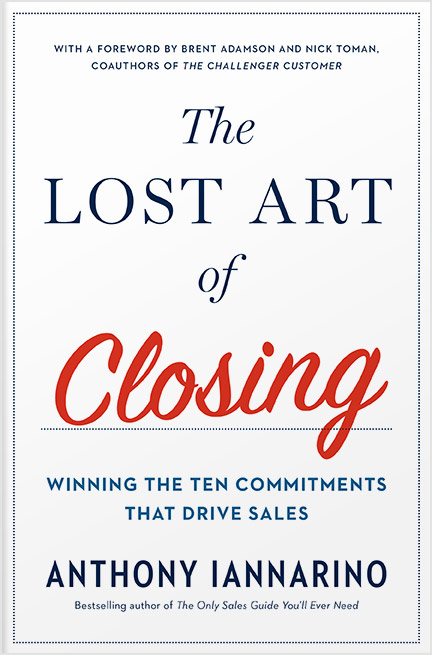In Eat Their Lunch: Winning Customers Away from Your Competition, I wrote about salespeople who struggle because they try to leverage things like their company’s history, and their leadership team, to create a competitive advantage in B2B sales. Unfortunately, the idea that your competitive advantage is external is not only incorrect; it produces precisely the opposite effect.Win customers away from your competition. Check out Eat Their Lunch
If you want to gain a competitive advantage in B2B sales, you are going to have to create that advantage yourself.
Get There First
A good starting point for creating an advantage is to get to your dream client first, long before any of your competitors. It is always better to be in front of an opportunity than behind it. This allows you to do the work of positioning yourself as a partner and creating a preference to work with you.
You want to protect your time by avoiding spending time on prospects who are not likely to change and focus on those who are motivated and compelled to change. Because all generalizations are lies, winning your dream clients means balancing the idea of protecting your time with investing it in meetings with the coldest of cold dream clients in your territory. It is an advantage to be known and to have some relationships before your prospect engages in an initiative to change.
Given a long enough timeline, every one of your dream clients is going to change partners. You want to be known when that happens if you can’t compel that change sooner through your actions, something that would provide you with an even more significant advantage.
Capturing Mindshare Early
Whether you are in front of an opportunity or slightly behind it, it pays to capture mindshare, something we might call dominating the narrative. You have a perspective on your prospective client’s challenges and opportunities, shaping their understanding of the root causes and implications positions you as someone who might be able to help.
The person who does the best work helping their contacts make sense of their world, their challenges, and their opportunities is capturing mindshare and gaining a competitive advantage. You gain an asymmetrical advantage through your business acumen and situational knowledge, a distinct mismatch over competitors who believe the value they create is found in their solution alone.
The better your ability to capture mindshare as early as possible, the higher your advantage. The stronger your narrative about why things are the way they are and what to do about them, the more you crowd out the rest of the field.
Physical Presence
If there is anything that creates a competitive mismatch in the digital age, it is showing up. Having a physical presence, showing up at your prospect’s location, and spending time in their world, puts you in a superior position.
The metric you might track is how many face-to-face meetings you’ve had and with how many different people. It’s easy to criticize activity metrics, but it is foolish not to recognize that people agreeing to face-to-face meetings is an outcome worth acknowledging by itself. It has become rare in an age when people sell over email (to their detriment).
If you have spent more time in your client’s building meeting with stakeholders than your competitors, you have the upper hand.
Create Greater Value
The person who wins is going to be the person who created the most significant value for their prospective client contacts, a part of which is your solution. There are a lot of ways to think about differentiation. Still, the outcome of differentiating must be felt as a benefit to the client. That means more unique value creation in your approach to the sales conversation.
Value creation is often a nebulous term (go here to read what value creation means now). For our purposes here, let’s start with the idea that your client needs to be better off for having met with you. Can they describe how they benefited from the meeting?
Your approach can create value, as can your business acumen, your depth of understanding, your preparedness, your follow-through, your advice, and your process.
Dominate Time
In The Lost Art of Closing: Winning the 10 Commitments That Drive Sales, I wrote about the need to control the process (i.e., the sales conversation) as you gain commitments that move your deals forward. This is something that by itself creates a strategic benefit. What I didn’t spend enough pages on in that book was the strategy of dominating time.No more pushy sales tactics. The Lost Art of Closing shows you how to proactively lead your customer and close your sales. 
The more time you spend with your contacts, helping them understand their choices, making decisions about what comes next and why, and guiding them through a process that will help them make the right decision for their business, the greater the likelihood they choose you—and the more likely you are stealing time from your competitors.
When you are in your prospect’s building, your competitor is not. When your contacts are investing time with you, they don’t spend with your competitors, and you are dominating the clock.
Vertical and Horizontal Strategy
In larger, complex, consultative B2B sales, the decision is all but certain to require consensus. If you are only working with one contact, you are likely on your back foot, behind the opportunity, and potentially losing to a competitor who has wired the building with relationships.
You want relationships on the vertical and horizontal axis. Having consensus on the vertical means you have connections in the departments responsible for buying what you sell. They are going to be impacted by the decision. The vertical includes the people you are going to be working with in the future when you win the opportunity.
The consensus in more massive deals is often broader, which means you need people in other departments. You need people in the ancillary departments, and people who are going to be in some way affected by the decision to change and buy from you.
Thriving in the Red Ocean
If you want to live, thrive, and survive in the red ocean that is business-to-business sales, winning means creating an advantage over your competition.








.jpg?width=768&height=994&name=salescall-planner-ebook-v3-1-cover%20(1).jpg)


